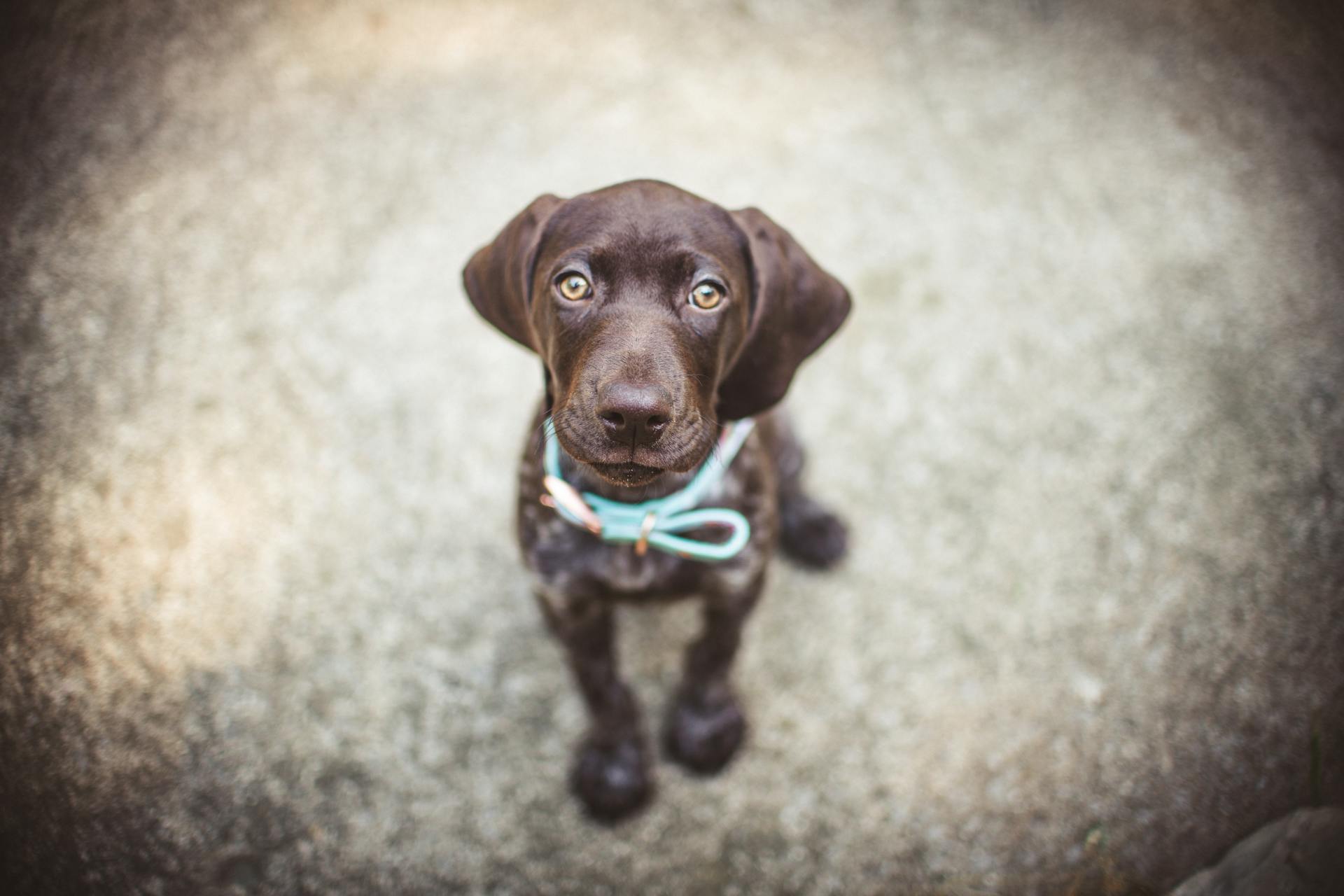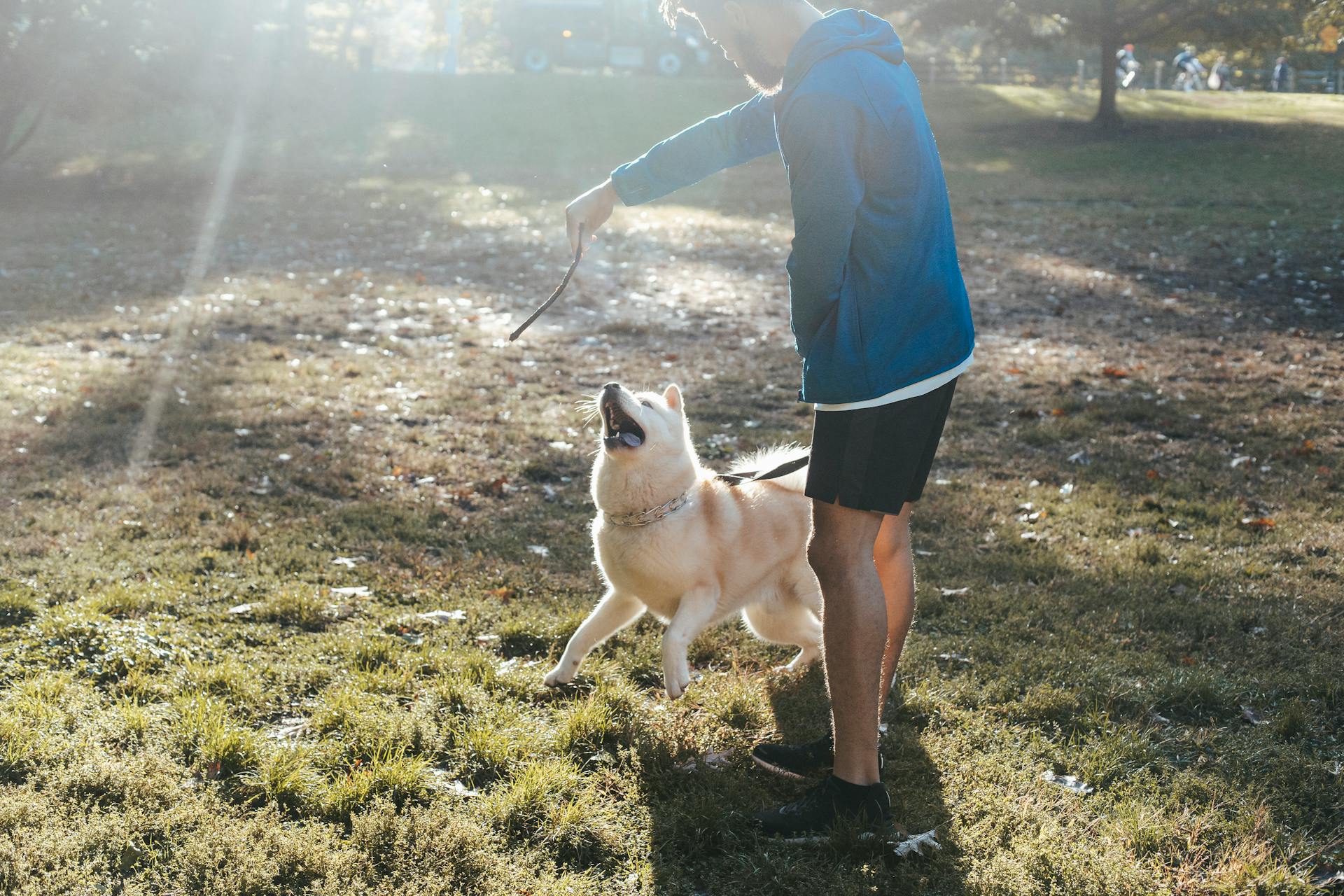
Dachshunds can be a bit stubborn at times, but with the right approach, they can learn quickly. They thrive on positive reinforcement and consistent training.
Their short attention span means training sessions should be short and frequent, ideally 5-10 minutes, 2-3 times a day. This will help them stay focused and retain information.
Dachshunds are highly intelligent dogs, ranking 31st in Stanley Coren's book "The Intelligence of Dogs."
Training Basics
Training a dachshund puppy requires some effort, but with the right approach, it can be a fun and rewarding experience for both you and your furry friend.
Crate training is essential to help with potty training and prevent accidents in the house. You'll need to introduce the crate gradually to your puppy, making it a comfortable and welcoming space.
To prevent unwanted barking, you'll need to address barking training, which can be achieved through positive reinforcement and consistent behavior. Chewing and nipping are also common issues that require attention, especially during the teething phase.
A fresh viewpoint: Crate and Potty Training
Socialisation is a crucial aspect of dachshund training, as it helps your puppy become confident and calm in new environments and around other animals. Lead training and recall are also vital skills to teach your dachshund, ensuring they walk nicely on a leash and respond to your calls.
Here are the basic training areas to focus on:
- Crate training
- Potty training
- Barking training
- Chewing and nipping
- Socialisation
- Lead training
- Recall
- Basic commands
Be Positive
Positive reinforcement is the key to training a dachshund. This means rewarding good behavior with treats and praise, and ignoring or calmly correcting any bad or undesirable behavior.
Shouting at your dachshund will only scare and confuse him, leading to frustration, anxiety, or aggressive behaviors down the line. Building a positive bond with your dachshund will make him a more confident and independent dog.
Dachshunds are much more likely to potty outside if they get rewards and praise for doing so. They then associate pottying outside with tasty treats and fun.
Set Boundaries
Setting boundaries with your dachshund is crucial for their development and your sanity. Consistency is key, so make sure you're patient and stick to your rules.
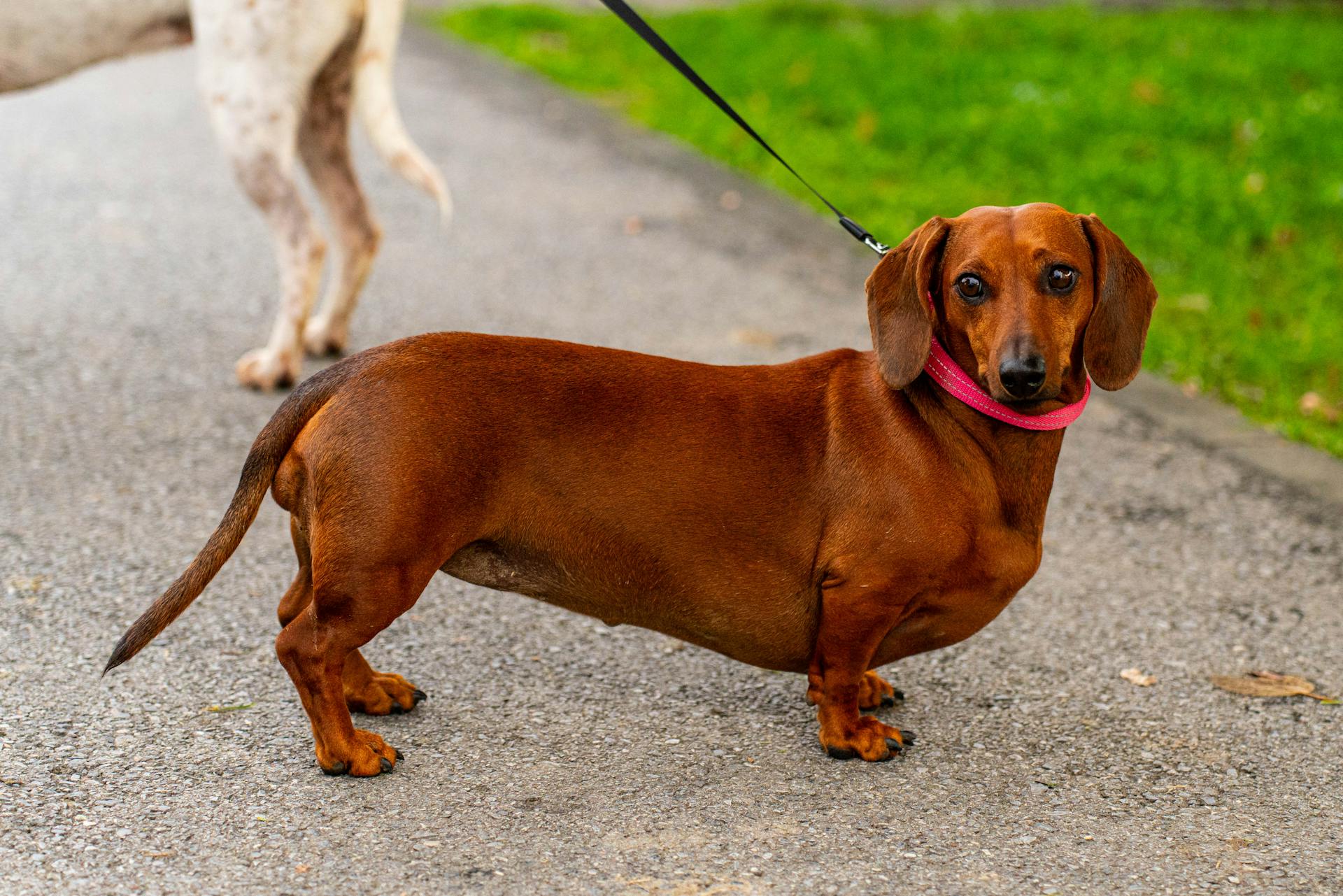
Deciding what you're going to allow your dachshund to do is a must. This could be as simple as not letting them on the sofa, but it's essential to stick to it.
For example, Alison Fleming, a dachshund owner and content creator, learned the importance of consistency the hard way. She had to decide what was allowed and what wasn't with her miniature wire-haired dachshund Jimmy.
Here are some essential training areas to focus on with your dachshund:
- Crate training
- Potty training
- Barking training
- Chewing and nipping
- Socialisation
- Lead training
- Recall
- Basic commands
Remember, setting boundaries is just the first step. You need to follow through with consistent training to see real results with your dachshund.
Be Consistent
Consistency is key when training a Dachshund. It's crucial to stick to your guns and give calm but clear corrections when they're young.
Dachshunds are known to do naughty things just to get your attention, so being firm but gentle is essential. This doesn't mean shouting or scolding, but rather being consistent in your training methods.
A unique perspective: When Do Dachshunds Calm down
Your puppy needs to know you're in charge, and that he's not in charge of you or anyone else in the family. This is why consistency is so important in training a Dachshund.
Being consistent will help prevent confusion in your Dachshund, especially when it comes to setting boundaries. If you let him on the sofa one minute and then scold him the next, he'll be totally confused.
Remember, Dachshunds are wilful and independent spirits, which is why consistency is so important in their training.
Using a Crate
Crate training is essential for Dachshund puppies, as they can spend time in their designated space.
Dachshunds like to be around humans, and crate training can make them feel lonely, encouraging them to resist living in their new home.
To prevent this, place their crate in a room with plenty of human activity, such as the living or family room, so your Doxie can keep an eye on the activities of other members without feeling like a stranger in the home.
Crate training helps Dachshunds relax in their crate when the outside environment becomes too much for them.
Recommended read: Dachshunds Seeking Forever Home Rescue
Socializing Puppies
Socialization is key for Dachshunds, especially in their puppyhood. You can enroll your Doxie in a puppy kindergarten 1 week after they have had their first set of vaccines and deworming.
These classes can help them learn how to coexist with other dogs and people. Puppies should be kept up to date with the rest of their vaccination schedule throughout the classes.
To get maximum results, you must choose the best trainer for your puppy. Basic obedience skills will be taught in an enjoyable manner, so your pup will learn how to respond when someone commands them to "stand" or "stay".
Once your Doxie knows how to get along with other dogs and a week has passed after the entire puppy vaccination schedule is completed, you can take them to your nearby dog-friendly park to help them socialize. This will help them become comfortable with this new life experience.
Worth a look: Dachshunds Dogs
Timing and Preparation
Timing is everything when training a dachshund. Dachshunds only understand what's happening right now, so rewards must be given immediately after a desired behavior.
To make training sessions a success, keep them short and sweet. Dachshunds have a shorter attention span than their adorable legs, so it's essential to keep sessions brief.
Find a quiet spot indoors for training, like an enclosed hallway or a small room. Avoid rooms with too much going on or noisy backgrounds, as this can divert your pup's focus away from you.
Time It Right
Start training your dachshund puppy when he's 8-12 weeks old. This is the perfect age for him to learn basic commands like 'Sit', 'Stay', and 'Down'.
You must reward your dachshund right away after he performs a desired behavior, like sitting. This will help him understand what he's being rewarded for.
Use a verbal cue like 'Good Boy' or 'Good Girl' to reinforce the connection between the behavior and the reward. Some people use a 'clicker' as a training tool to make this connection clear.
Keep training sessions short to avoid overwhelming your dachshund, especially when he's young. Dachshunds only understand what's happening right now, so it's essential to reward them immediately.
On a similar theme: Are Dachshunds Good Pets
Preparation
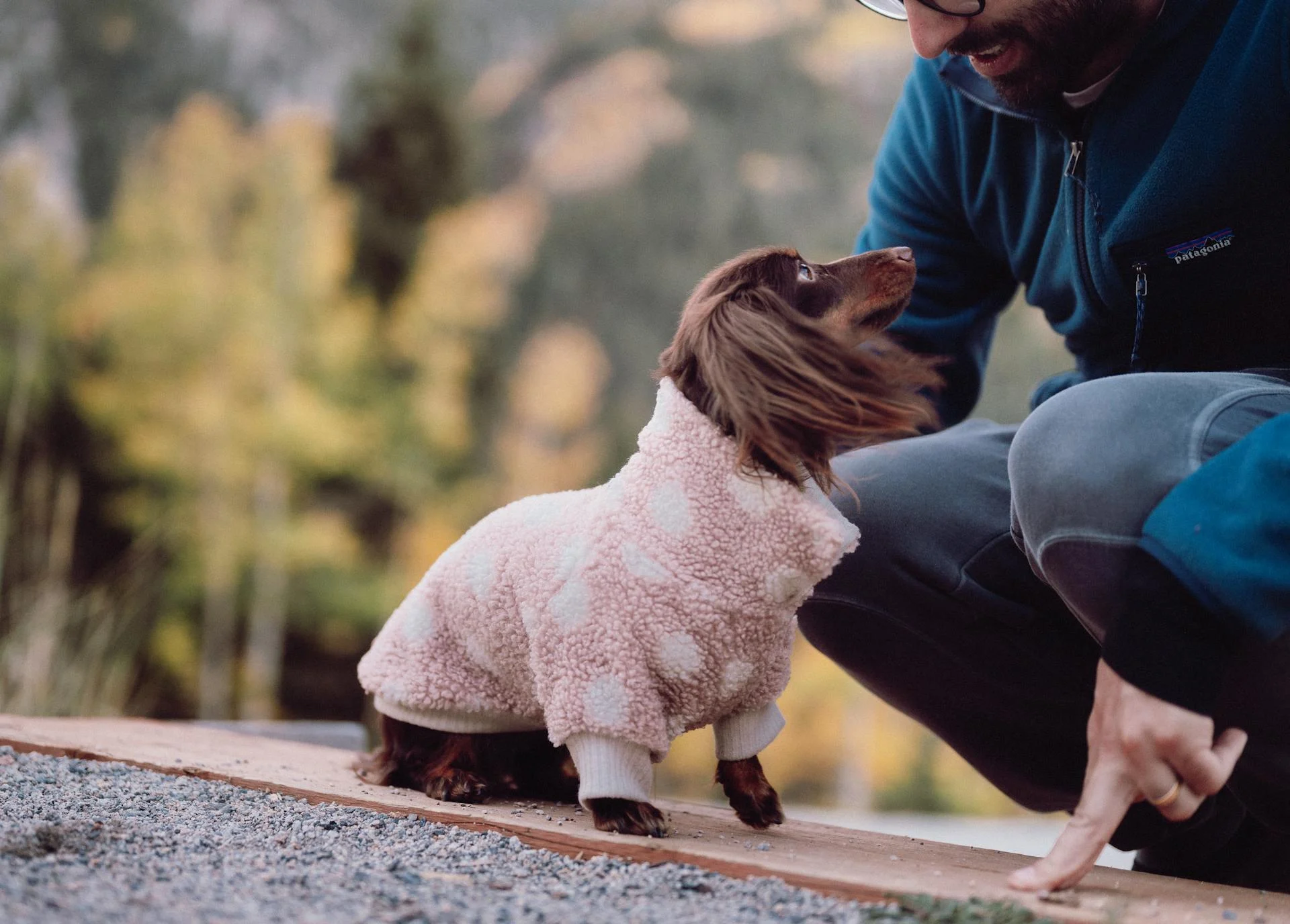
Preparation is key. Dachshunds are quick to learn, but their attention span is shorter than you'd think.
Find a quiet spot indoors for training, like an enclosed hallway or a small room. This will help minimize distractions and keep their focus on you.
Keep training sessions short and sweet, as Dachshunds have a shorter attention span. Tasty treats can be a great motivator, so get those ready too.
Stick to a calm and controlled environment indoors for better results. Avoid rooms with too much going on or noisy backgrounds, as they can easily divert your pup's focus away from you.
Common Challenges
Dachshunds can be stubborn and independent, which makes training them a challenge. They're prone to selective hearing, especially around things they perceive as threats.
Their strong will and instincts can lead them to ignore commands or follow their own impulses. This is especially true when they're faced with triggers like people, dogs, or loud noises.
To overcome these challenges, you need to teach your dachshund self-control and help them contain their impulses. One key is to use a training system with no loopholes in the rules, which can be a departure from traditional treat-based methods.
Problem #1: Digging
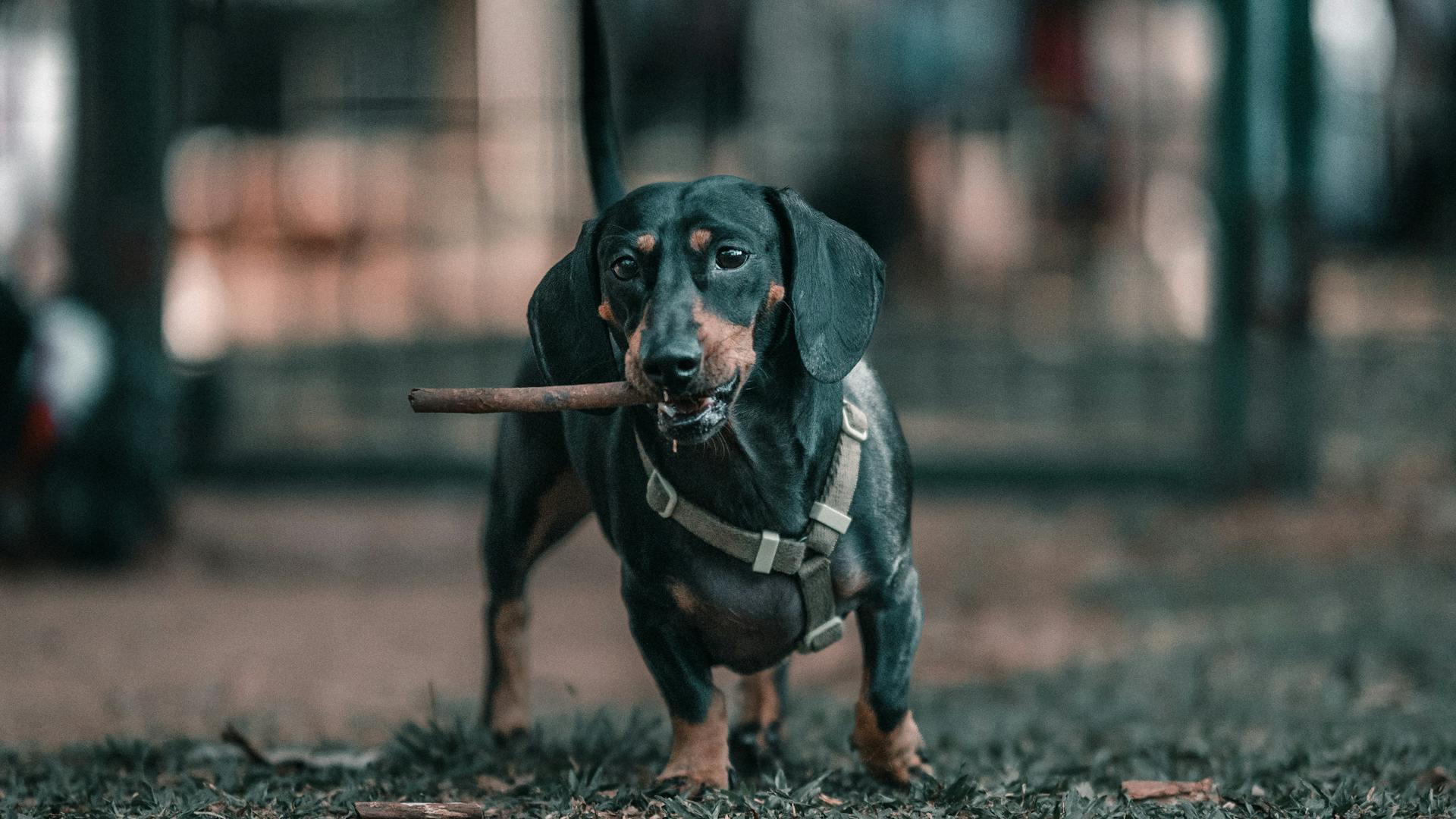
Dachshunds have a natural tendency to dig, thanks to their breeding history of chasing badgers in underground burrows. This trait can be a challenge to deal with, especially when it happens when you're not around.
Digging often occurs when you're not present, making it hard to teach your dog not to do it. You can try setting up a digging zone, like a sandpit, to encourage your dog to dig in a specific area.
Dachshunds need to be taught that digging isn't acceptable, and a treat-free training system can be effective in this scenario. It's essential to use this approach when you're not physically present to supervise.
Giving your dog an outlet to dig can help redirect their behavior, but only do this if your dog is already a digger. If they're not, you might create a new problem by encouraging a habit that didn't exist before.
Cultivating a thoughtful mindset in your dachshund can help indirectly with issues like digging. This involves teaching them to think through their options and make the right decision, which can be beneficial in all areas of their life.
You can also keep your dog entertained and engaged by giving them things to do in the backyard, such as a walk or some training to tire their brain out. This can help prevent digging when you're not around.
Common Challenges
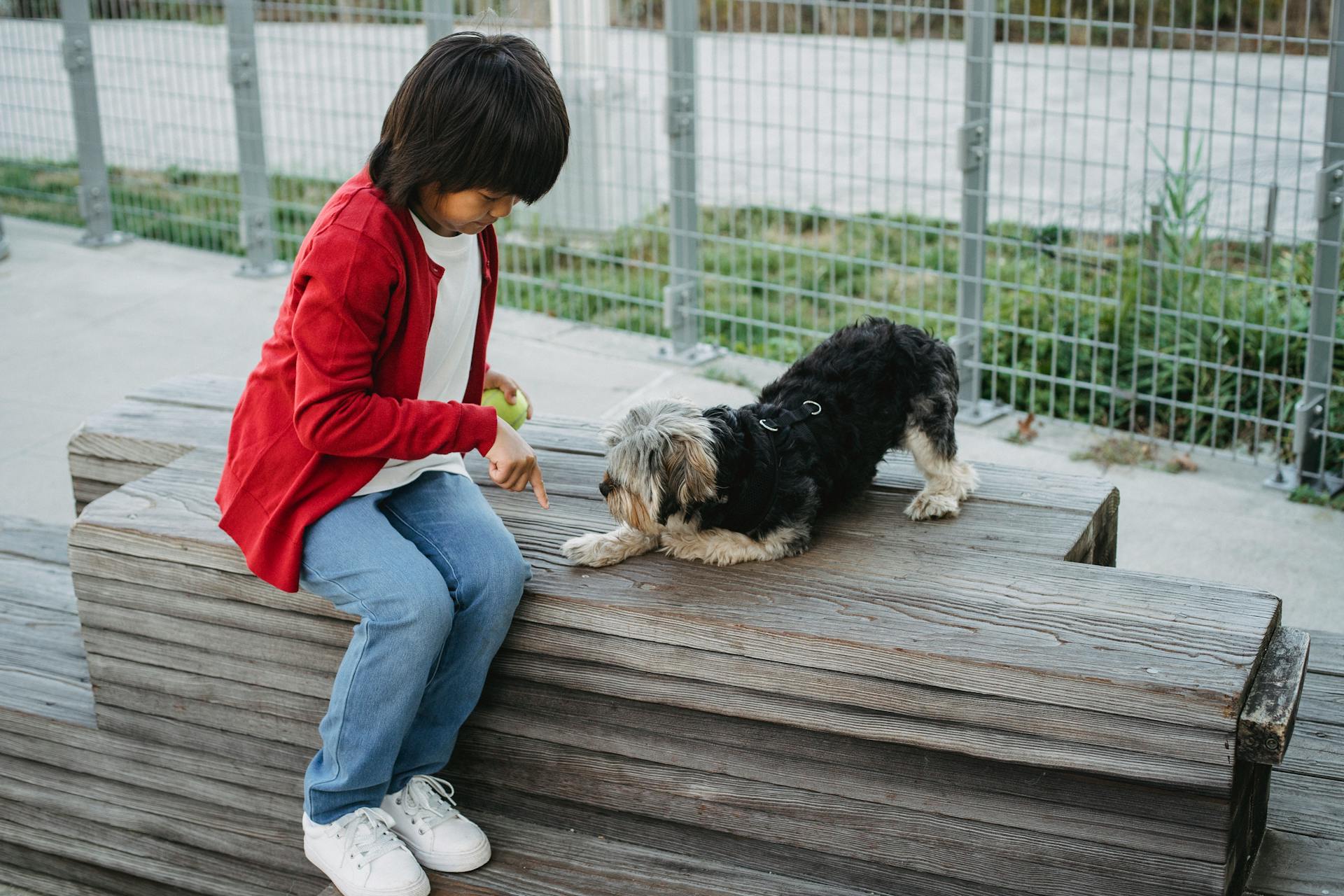
Dachshunds can be prone to overreacting to everyday stuff like people, dogs, and car noises. They were bred for badger hunting, which means they're often more reactive and aggressive than they need to be as a pet dog.
Their breed history of going down holes to hunt badgers has made them more likely to be reactive towards things like people, dogs, birds, cars, or bikes. This can lead to barking, leaping, and growling, even when there's no real threat.
Dachshunds can be stubborn and independent, making them challenging to train. They'll happily take on "threats" much larger than themselves, which can make training them to listen reliably even more difficult.
Their strong instincts can make them think the world needs to be notified about every little noise they hear. This can result in barking at almost everything, from car doors slamming to people walking past on the footpath.
To overcome these challenges, it's essential to use a training system that actually works, even when they're amped up or want to do something else. This means avoiding common strategies like ignoring them when they bark or telling them "quiet" and giving them a treat once they stop.
For another approach, see: Dachshunds Barking Sounds
Patience
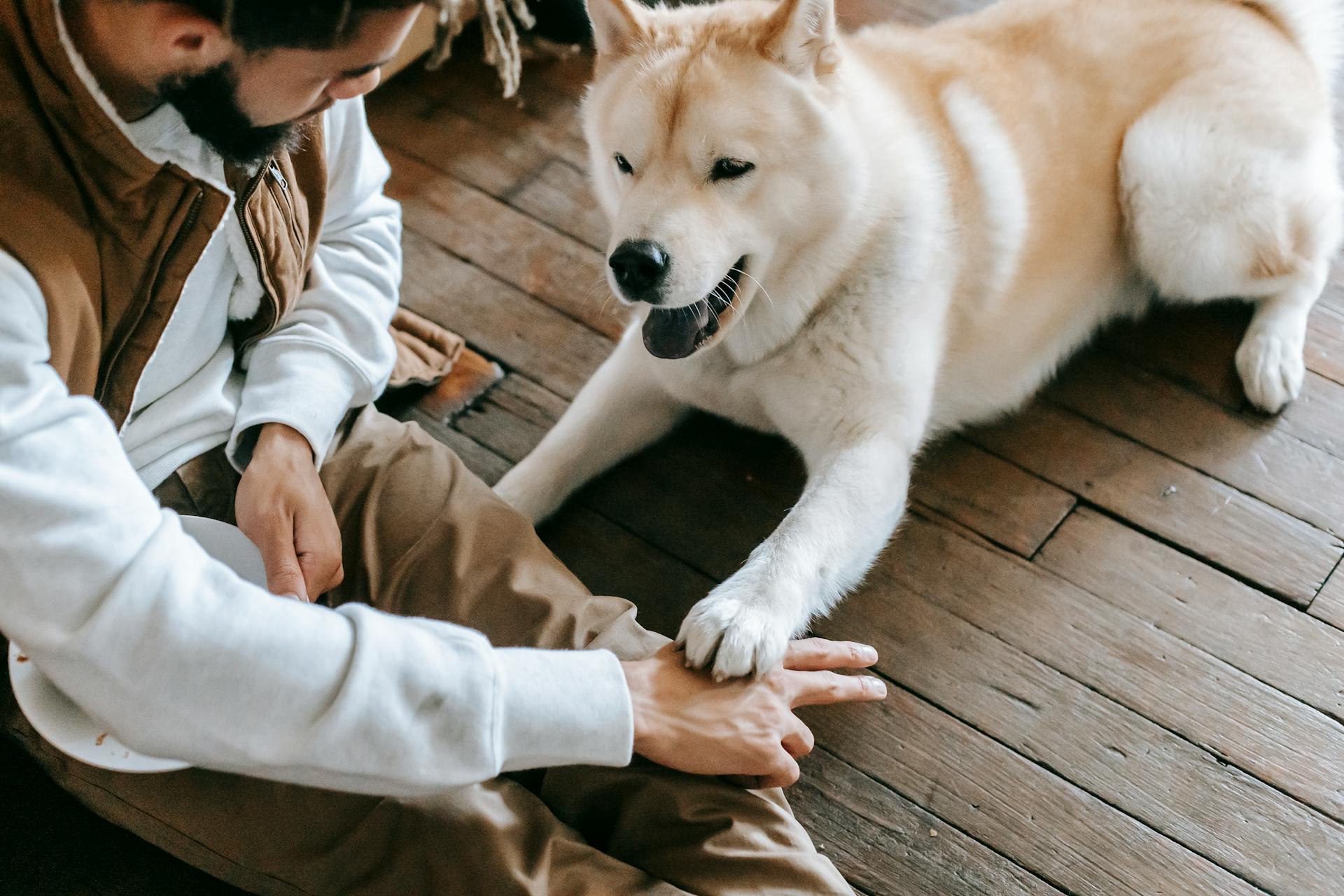
Patience is key when training your Dachshund, as some pups catch on really quick, but others may take extra time to get the command down pat.
Understanding that this is all part of the learning process is crucial. No matter how long each command takes for your doxie, they will enjoy training with you – if you keep it positive!
A calm and cheerful tone is essential when giving commands. Avoid using firm disciplinary tones, as your dog will find training much more enjoyable when you use a friendly voice.
Things to Remember About Dachshund Temperament: Stubbornness
Dachshunds can be surprisingly stubborn, despite their cuteness. They're definitely a dog who prefers to get their own way!
Training a dachshund can be great self-development for you too – teaching patience, perseverance and becoming aware of your own emotions and energy and how they affect your dog's responses.
A dog's breed can have a large effect on how easy it is to train them, and dachshunds were bred to work independently. They were bred to go down holes after badgers, which means they're used to making decisions, calling the shots, and being fierce and confident in taking on something much larger and scarier than themselves.
Take a look at this: Dachshunds Bred for Hunting
Training your dachshund requires being more stubborn than they are, as they're likely to use loopholes in the rules to get what they want. This is especially true for independent breeds like dachshunds.
Dachshunds can vary hugely in personality, even within the same litter, so breed isn't a guarantee that you're going to get a certain "type" of dog.
Training Commands
Training commands with your dachshund is a great way to strengthen your bond and improve their behavior. With consistency and patience, you can teach them a variety of commands.
Some commands you can teach your dachshund include Sit, Stay, Down, Leave, Come, Fetch, Drop, Paw, Round, Speak, Quiet, Sing, Gently, and Back. These commands are a great starting point for beginners.
Teaching a Dachshund to Stay can be done in two parts, taking about two weeks to complete. Start by having your dog sit and facing you, then show them a stop sign with your palm and say "Stay". If they stay, praise them and give a treat.
Here's a list of some basic commands you can teach your dachshund:
- Sit
- Stay
- Down
- Leave
- Come
- Fetch
- Drop
- Paw
- Round
- Speak
- Quiet
- Sing
- Gently
- Back
Remember to consider your dachshund's back when teaching new commands or tricks, as 1 in 4 dachshunds are prone to Intervertebral Disc Disease (IVDD).
Stay
Count 2 seconds, then praise your pup with "Good" and give a treat if they stay. Repeat this process, increasing the count to 3 seconds, 4, 5, and so on, up to 30 seconds. Practice this for a week before moving on to part two.
The second part of teaching your Dachshund to stay involves taking a couple of steps backwards while saying "Stay" and rewarding your pup with praise and a treat if they stay. Gradually increase the distance and time your pup needs to stay, taking it one step at a time.
To help you keep track of your progress, here's a breakdown of the steps involved in teaching your Dachshund to stay:
- Part One: Sit, show palm, say "Stay", count 2 seconds, praise and treat.
- Part Two: Sit, take steps back, say "Stay", reward with praise and treat.
Remember to take your time with the second part, as it may take some extra practice for your pup to master the "Stay" command. But with patience and consistency, your Dachshund will learn to stay in no time.
Come
The "Come" command is a fundamental part of any dog training routine.
This command can be taught in various environments, including at home, in a park, or on a walk.
The "Come" command is a recall command, which means it's used to bring your dog back to you when they're not by your side.
In our previous section, we discussed how to create a safe space for your dog to learn and respond to commands, including the "Come" command.
To teach your dog to come, start by having them on a leash and calling them by their name before giving the command.
As you practice the "Come" command, be sure to reward your dog with treats and praise when they respond correctly.
Touch
Training your dachshund to touch is a fun and easy command to teach. You can start by sitting on the floor with your pup in front of you, then cup your treats in one hand and hide them behind your back.
To get your dachshund to touch your hand, simply show them your empty hand, palm out, fingers facing down. If they touch your palm, praise them with "Good" and give a treat.
This command is so much fun, and it's super easy to learn. You can repeat this process several times before moving on to the next step.
Once your dachshund gets the hang of touching your hand, you can start saying "touch" when you present your hand to them. If they touch your palm, praise them with "Good" and give a treat.
To keep things interesting, change up your position and hands occasionally. You can also check out our video guide on YouTube for a visual demonstration of the touch command.
Here are the steps to teach your dachshund to touch in a nutshell:
- Sit on the floor with your pup in front of you.
- Cup your treats in one hand and hide them behind your back.
- Show your empty hand to your dachshund, palm out, fingers facing down.
- Praise your dachshund with "Good" and give a treat if they touch your palm.
- Repeat several times before moving on.
- Say "touch" when you present your hand to your dachshund.
Discourage Leash Pulling
Discourage Leash Pulling is a crucial part of training commands, especially for Dachshunds who get excited on walks. They'll learn that pulling gets them nowhere.
Stand still when your Doxie starts pulling on the leash, as this will help them calm down and understand that pulling isn't effective. Once they're calm, you can relax the leash and continue walking.
Giving your Doxie their favorite treats during the walk can encourage good behavior and help them learn good leash etiquette. They'll soon associate walking calmly by your side with rewards.
You might enjoy: Beagle Doxie Puppies
Housebreaking and Behavior
Breaking down training into smaller sessions is key to keeping your Dachshund puppy from getting too tired. This approach ensures they'll actually enjoy their training.
You can start house training your Dachshund as soon as you bring them home, and it's generally easier if you've already crate-trained your puppy. Dogs take several weeks to complete their house training, so be patient.
It's essential to reward your Dachshund with treats and praise when they pee outside to help them understand that it's a good thing. Never rush your Doxie to eliminate outside, as it can make them anxious and lead to accidents inside the home.
By making the elimination process a positive experience, you'll be well on your way to successful housebreaking.
Dachshund Specifics
Dachshunds are a bit stubborn, but with consistent training, they can learn to obey commands.
They have a short attention span, so training sessions should be short and fun.
Dachshunds are highly intelligent, ranking 38th in Stanley Coren's book "The Intelligence of Dogs" among 138 breeds.
Their strong prey drive and hunting instincts can make them distracted during training, so it's essential to keep them engaged.
They are also prone to barking, which can be a challenge to manage during training.
Frequently Asked Questions
Is Dachshund a good dog for beginners?
Yes, Dachshunds can be a great choice for first-time dog owners, but they do require patience and consistent training. With the right approach, they can thrive as a loyal companion for beginners.
Is it difficult to train Dachshunds?
Yes, Dachshunds can be challenging to train due to their independent nature and strong will. With patience and consistency, however, they can learn to obey commands and become well-behaved companions.
Sources
- https://www.ilovedachshunds.com/are-dachshunds-easy-to-train/
- https://www.bestmatedogtraining.co.nz/training-dachshunds
- https://www.dachshundstation.com/dachshund-commands-anxiety/
- https://youdidwhatwithyourweiner.com/are-dachshunds-hard-to-train/
- https://www.dogster.com/dog-training/how-to-train-a-dachshund
Featured Images: pexels.com
